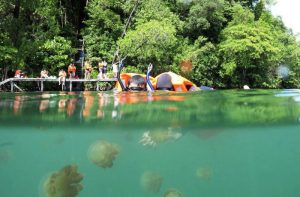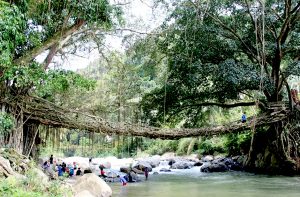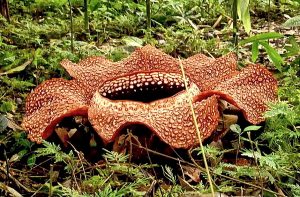 Swimming with Jellyfish
Swimming with Jellyfish
There are only two places in the world where you can swim with sting-less jellyfish, and one of them is in Indonesia. To achieve this, first make your way to the Derawan Islands in East Kalimantan before taking a 1.5 hour boat ride to Kakaban. Jellyfish Lake as it is known, was once connected to the ocean but became cut off by a deep wall of mangroves, creating a secluded lake. Come prepared with a GoPro to capture the four different types of jellyfish that live in the lake.
 The Root Bridge over Batang Bayang River
The Root Bridge over Batang Bayang River
Extending over the Batang Bayang River in Indonesia, the slowly growing Jembatan Akar (Root Bridge) is made entirely out of the roots of two banyan trees that have been slowly cultivated to knit into a walkable bridge.
The Jembatan Akar, meaning “root bridge”, was first conceived in 1890 by a local teacher who wanted improve access to his classes for students from a village across the river. To start the bridge, he put a bamboo frame in place and began wrapping the fast growing aerial roots of the banyan trees on either side of the water along the frame. Ever so slowly, the bridge began to take shape.
The project took 26 years of carefully tended growth to become sturdy enough to support anyone. The 100-foot span has since been shored up and reinforced with wooden planks and metal cables as well as becoming stronger year after year as the massive roots of the still-living trees continue to grow. Guide lines have also been added to provide additional support for visitors.
 Monster-sized Petals of Rafflesia
Monster-sized Petals of Rafflesia
It’s a plant with no leaves, no roots, no stem and the biggest flower in the world! Sir Stamford Raffles discovered this spectacular plant in 1818, and today it’s is one of the world’s rarest plants on the brink of extinction. Rafflesia can grow to over one metre in width when in full bloom and weigh up to 11 kilograms with petals an inch thick. It takes about nine months to mature and the bloom only lasts for a week. This parasitic plant is also one of the worst smelling, designed to imitate rotting meat. It is now hanging on to a precarious existence in a few pockets of Sumatra, Borneo, Thailand and the Philippines, struggling to survive against marauding humans and its own limited ability to germinate.